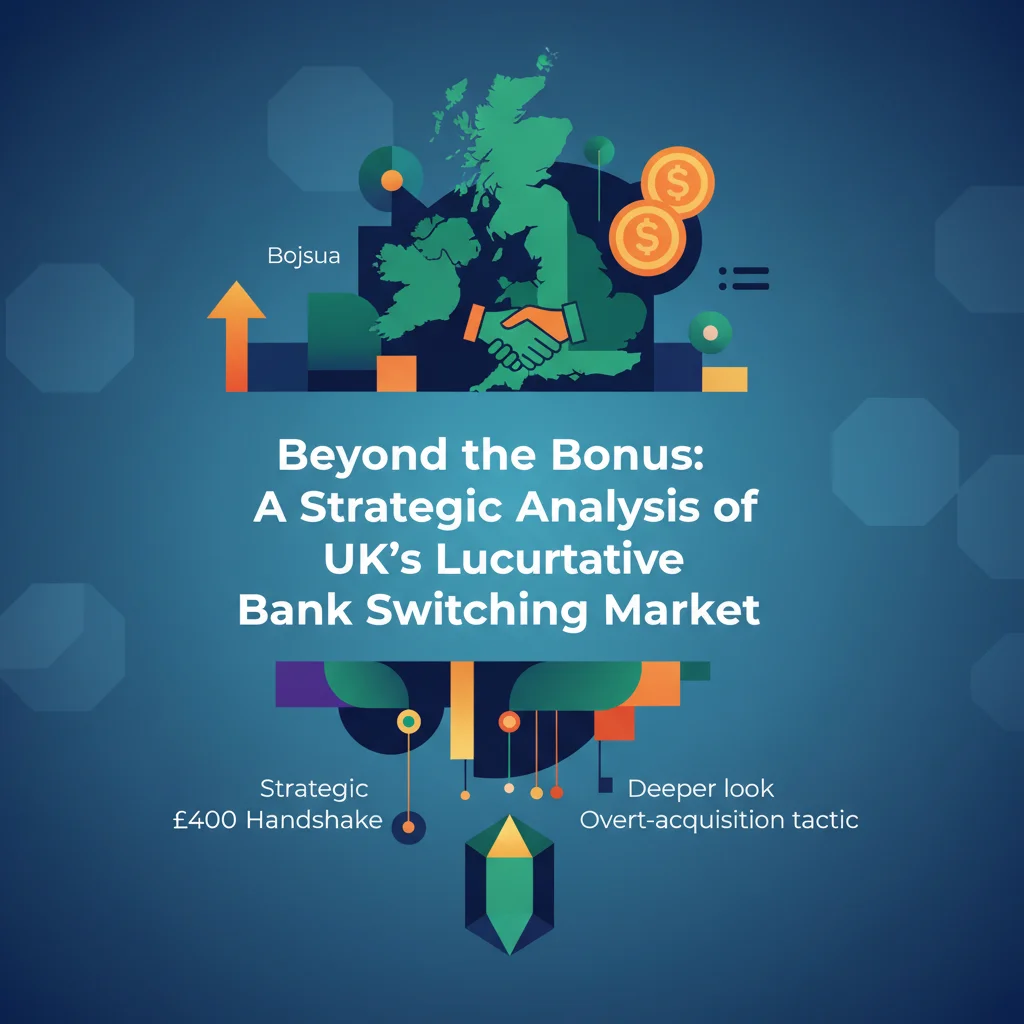
Beyond the Bonus: A Strategic Analysis of the UK’s Lucrative Bank Switching Market
The £400 Handshake: A Deeper Look into Retail Banking’s Most Overt-Acquisition Tactic
In the dynamic world of personal finance, the concept of “free money” is often met with healthy skepticism. Yet, for the discerning consumer, a significant opportunity exists to generate hundreds of pounds in cash, not through complex trading on the stock market or speculative investing, but directly from the high-street banks themselves. Financial journalist Martin Lewis recently highlighted how consumers can secure up to £400 in tax-free cash simply by switching their current accounts (source). While this is compelling advice for anyone looking to bolster their finances, it also serves as a fascinating entry point into a much larger conversation about the fierce competition, strategic economics, and technological disruption reshaping the modern banking landscape.
This practice, far from being a simple gimmick, is a calculated and increasingly aggressive strategy employed by financial institutions. It’s a direct reflection of the intense battle for customers in an era defined by the rise of fintech, the pressures of a fluctuating economy, and the evolving expectations of the digital-native consumer. This article will not only dissect the practical steps for capitalizing on these offers but will also delve into the sophisticated financial mechanics and strategic imperatives that compel a bank to pay you for your business. We will explore the underlying economics, the impact of financial technology, and what this trend signifies for the future of finance and investing in the retail banking sector.
The Consumer Opportunity: Capitalizing on Market Competition
At its core, a bank switching bonus is a cash incentive offered by a retail bank to persuade you to close your existing current account with a competitor and open one with them. These offers are not new, but their value and prevalence have surged in recent years. The process has been dramatically simplified in the UK by the Current Account Switch Service (CASS), a free and guaranteed system that has become a cornerstone of modern consumer banking.
Launched in 2013, CASS ensures that the entire switching process is completed in just seven working days. It automatically transfers all your incoming and outgoing payments, including your salary and direct debits, as well as your account balance, to the new account. According to Pay.UK, the service has facilitated over 9.9 million account switches and boasts a 99.7% satisfaction rate (source), demonstrating the power of purpose-built financial technology in removing friction and empowering consumers. This seamless infrastructure is the engine that drives the competitive switching market.
To illustrate the potential returns, let’s examine a comparison of typical offers currently available in the market. While specific details change frequently, the structure of these incentives is often similar.
| Bank Provider | Typical Cash Bonus | Key Requirements for Bonus | Additional Perks |
|---|---|---|---|
| Example Bank A (e.g., Nationwide) | £200 | Switch a full current account, transfer 2+ active Direct Debits. | Access to high-interest regular saver accounts. |
| Example Bank B (e.g., First Direct) | £175 | Pay in £1,000 within 3 months of opening. | Award-winning customer service, fee-free overdraft facility up to a certain limit. |
| Example Bank C (e.g., TSB) | £150 + Cashback | Make 5 debit card payments and log into the mobile app each month. | Ongoing monthly cashback rewards on spending. |
As the table demonstrates, securing these bonuses requires careful attention to the terms and conditions. However, for the organized individual, meeting these criteria is a straightforward process that yields a significant, risk-free return on a minimal time investment. It is, in essence, one of the simplest and most accessible forms of financial optimization available today.
The €150 Loophole: Why Europe is Cracking Down on Shein and Temu, One Package at a Time
The Banker’s Gambit: The Economics of Customer Acquisition
From the perspective of investors and finance professionals, the crucial question is: why are banks willing to give away what amounts to billions in collective payouts? The answer lies in a fundamental business calculation: the trade-off between Customer Acquisition Cost (CAC) and Lifetime Value (LTV). A current account is the gateway to a customer’s entire financial life. It is the foundational product upon which banks build profitable, long-term relationships.
A customer who holds a current account with a bank is exponentially more likely to turn to that same institution for higher-margin products, including:
- Mortgages and Personal Loans: The most profitable products for retail banks.
- Credit Cards: A consistent source of revenue through interest and fees.
- Savings and Investing Products: Platforms for wealth management and asset growth.
- Insurance: Cross-selling opportunities for home, life, and travel insurance.
A study by the UK’s Competition and Markets Authority (CMA) highlighted the “stickiness” of current account customers, noting that many people are more likely to get divorced than to switch their bank (source). This inertia means that once a bank acquires a customer, they are likely to retain them for years, if not decades. Therefore, a £200 upfront payment is a remarkably efficient marketing expense when compared to the potential multi-thousand-pound LTV of that customer. This intense competition is further fueled by the rise of digital-first fintech challengers, which have forced legacy institutions to compete more aggressively on both technology and price.
Broader Market Implications: A Barometer for the Economy and Banking Sector
This trend has significant implications that extend beyond the individual consumer and the bank’s marketing department. For those observing the broader economy and stock market, the intensity of the switching market can serve as a useful, albeit informal, economic indicator.
Firstly, it signals a highly competitive and relatively healthy retail banking sector. Aggressive competition, spurred by regulatory action and fintech disruption, ultimately benefits the consumer and forces incumbents to innovate. For investors analyzing banking stocks, these acquisition campaigns represent a critical strategic decision. While they can compress net interest margins in the short term—a key metric watched closely in earnings reports—they are also an investment in future revenue growth. An analyst might view a bank’s willingness to spend on acquisition as a sign of confidence in its ability to retain and monetize new customers effectively. The success or failure of these campaigns can influence trading decisions and long-term valuations.
Secondly, the macroeconomic environment plays a crucial role. In a higher interest rate environment, as has been the case recently, banks earn more on the cash deposits held in current accounts (the spread between what they pay on deposits and what they earn on loans). This increases the profitability of each customer, justifying a higher CAC and fueling more generous switching offers. Conversely, in a zero-interest-rate period, these offers tend to become less generous or disappear entirely. Therefore, the state of the switching market provides a real-time glimpse into the operational dynamics of the banking sector as it relates to prevailing economics.
Beyond the Ticker: A Deep Dive into Tesco, CVS, and Wetherspoon's Investment Potential
A Strategic Checklist for the Savvy Switcher
While the headline bonus is the primary attraction, a strategic approach requires looking beyond the initial cash injection. The best bank account is not necessarily the one with the biggest welcome bonus, but the one that offers the best long-term value for your specific financial profile. Before making a move, consider a holistic view of the product.
Here is a checklist of factors to evaluate when comparing accounts:
| Consideration | What to Look For |
|---|---|
| Overdraft Facility | Compare the interest rate (APR) and any fee-free buffer amounts. A high overdraft rate can quickly negate a cash bonus. |
| Linked Savings Accounts | Does the account provide exclusive access to high-interest regular saver or easy-access savings accounts? |
| Customer Service Reputation | Research independent reviews (e.g., from Trustpilot or consumer groups) to gauge the quality of support. |
| Mobile App & Fintech Features | Evaluate the app’s user interface and features like spending categorization, savings pots, and payment options. |
| Monthly Fees & Other Charges | Ensure there are no monthly account fees, or if there are, that the benefits (e.g., travel insurance) justify the cost. |
| Credit Score Impact | Be aware that applying for a new account involves a hard credit check. While minor, multiple applications in a short period can temporarily lower your score. |
By using this framework, you can ensure your decision is based on a comprehensive assessment of value, transforming a simple switch into a strategic financial upgrade.
The Prancing Horse Goes Electric: An Investor's Guide to Ferrari's High-Stakes EV Future
Conclusion: From Consumer Tactic to Market Insight
The act of switching a bank account for a cash bonus is far more than a simple money-saving hack. It is a direct engagement with the powerful forces of competition, innovation, and economic strategy that define the modern financial services industry. For the individual, it represents a clear, actionable way to leverage market dynamics for personal gain. For the finance professional, investor, or business leader, it offers a revealing window into customer acquisition costs, the impact of financial technology on legacy institutions, and the health of the retail banking economy.
By understanding both the “how” and the “why” of this phenomenon, we can appreciate it not just as a transaction, but as a telling symptom of an industry in flux. As consumers, it empowers us to be active participants in the market. As observers of that market, it provides a valuable and tangible data point on the ever-evolving relationship between corporations and the customers they seek to serve.


